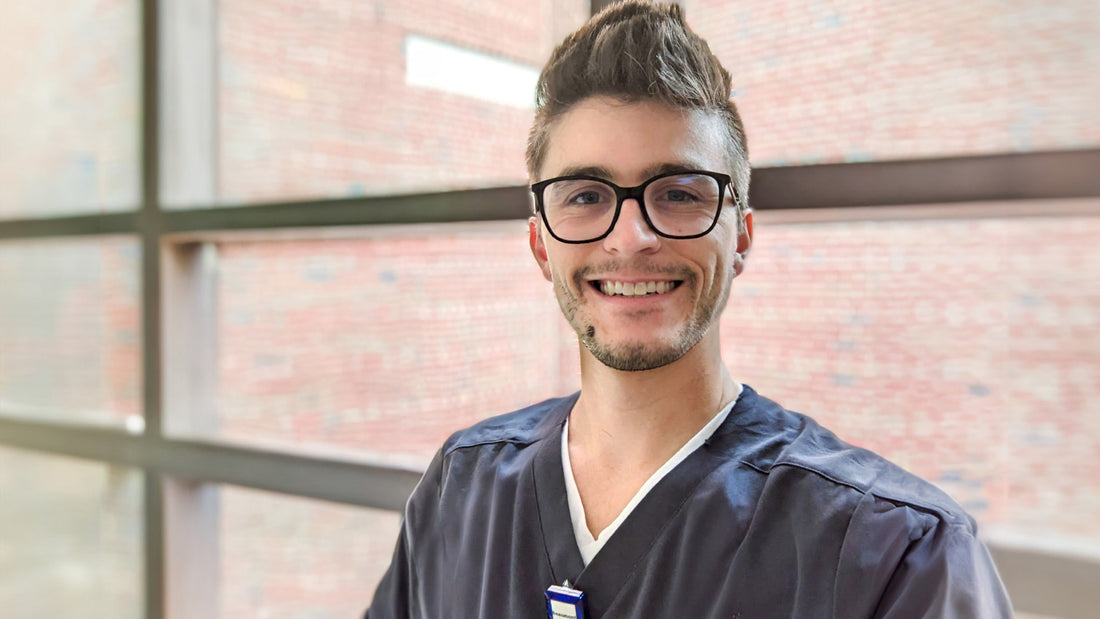Family heartstrings
Tyler Bonkowski, DO, knew from a young age that he wanted to be a heart doctor. Growing up on the west side of Michigan, he had two close relatives who needed significant cardiology interventions.
“I was exposed to this field at a fairly young age. Both my dad and my grandpa had significant cardiac events — one underwent cardiac bypass surgery and the other a coronary stent, both prior to age 55. It sparked my interest in wanting to take care of patients like my dad, like my grandpa — making them feel better, able to live their lives again,” he said. “I studied the basic medical sciences and was really interested in the physiology of the heart — just how dynamic and how amazing a system it really is. And that cemented my career choice.”
Dr. Bonkowski went on to study internal medicine and is now a cardiology fellow in Dearborn, Michigan. He treats adult patients with acute and chronic heart conditions in the inpatient and outpatient settings. He rounds on the general hospital floors and the cardiac intensive care unit.
“When first assessing a patient, I ask myself: Is this patient sick or not sick? Do I have to do something right now to change their trajectory? Or do I have time to review their charts and their history, determine what could be contributing to their presenting problem, order some tests and figure things out?” Dr. Bonkowski said. “You may not get a complete story from the emergency department, and you may not have time to completely review the chart and determine the underlying cause.”
Using digital stethoscope technology to hear heart sounds in large body habitus
To make that initial assessment, Dr. Bonkowski relies on certain data, particularly the patient’s heart sounds. “It’s essential to be able to accurately auscultate heart sounds relatively quickly, especially in patients that are in that sick category,” he said.
However, heart sounds can be very difficult to hear in patients who have respiratory comorbidities and/or excess weight. He noted that obesity is prevalent in Michigan and a common comorbidity among cardiology patients.
So, he purchased an Eko CORE Digital Attachment for his analog stethoscope. “One thing that is really nice with Eko’s technology is the ability to amplify heart sounds. Sometimes it’s more difficult with a traditional stethoscope, and having the amplifying feature definitely helps me gather that important information a little bit quicker and arrive at the initial decision,” he said.
Test driving a new generation of stethoscope
Eko Health recently asked Dr. Bonkowski to test drive its new stethoscope: the Eko CORE 500™ Digital Stethoscope. This model has several features helpful in cardiology, such as instant auscultation data on a full-color display that includes heart rate and ECG tracing.
With the CORE 500™’s newest audio innovation, TrueSound™, he said the sounds are sharper and more refined when compared to his previous generation of CORE, with less distortion and less artifact. “It was like using a telemetry monitor and listening to a patient at the same time,” he added. Dr. Bonkowski found the amplification and noise cancellation to be particularly helpful.
“It kind of started as more of a party trick than anything. My healthcare colleagues would notice the full-color display and ask about it. They were pretty amazed that it was able to give a full rhythm strip right on the stethoscope and take recordings when connected to the Eko App,” he said. “But then I used it on patients when I wasn’t sure whether they were in atrial fibrillation (AFib) or just having premature beats. I could throw that device on their chest and clearly identify a premature ventricular beat based on the rhythm strip. It’s also beneficial because you can identify when murmurs occur during the cardiac cycle, systole vs diastole. There’s a big difference between the two, and making that distinction is difficult even among a lot of seasoned physicians because the diastolic murmurs aren’t as common, and they’re more difficult to hear.”
The CORE 500™ is lightweight and shatter-, splash-, and scratch-resistant. “The battery would last me several shifts,” Dr. Bonkowski added. “I would charge it once a week, leaving it plugged in for the weekend, then it would be ready to go Monday and last the whole week.”
The promise of artificial intelligence in cardiology
Dr. Bonkowski sees great potential in using digital technology and artificial intelligence to improve the practice of cardiology. For example, the Eko CORE 500™ can be paired with Eko’s artificial intelligence (AI) products, which are cleared by the U.S. Food and Drug Administration. This can help clinicians quickly flag abnormalities, such as atrial fibrillation, bradycardia, and tachycardia.
“I see it improving the standardization of diagnosis, leaving less up to interpretation, and ensuring that the diagnosis is accurate. AI can identify patterns in a fraction of the time it takes to train a physician to do the same with equivalent accuracy. Specifically in my practice, it helps me confirm my diagnosis of the patient’s rhythm without the need for a formal EKG,” Dr. Bonkowski said. “If I disagree with the reading or there’s a conflicting interpretation, it makes me ask why. And then I listen more carefully or take a second look. Either way, it forces me to spend more time thinking about the patient, and the patient is better off for that.”
Learn how the Eko CORE 500™ Digital Stethoscope can help you hear and identify heart sounds to deliver the best patient care.
MKT-0002135
